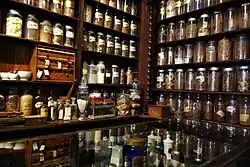 Interior view, 2015 | |
Interactive fullscreen map | |
| Established | 1950 |
|---|---|
| Location | 514 Chartres Street, New Orleans, Louisiana, US 70130 |
| Coordinates | 29°57′22″N 90°03′54″W / 29.9560°N 90.0649°W |
| Director | Elizabeth Sherman |
| Website | pharmacymuseum |
The New Orleans Pharmacy Museum is a museum located in the French Quarter of New Orleans that showcases the world of early pharmacies and medicine and describes development of the pharmaceutical industry and healthcare practices in the 19th century.[1][2] It is the largest collection of pharmaceutical memorabilia in the United States.[1] The building is the former residence and apothecary of America's first licensed pharmacist, Louis J. Dufilho, Jr.[2][3][4] Difulho was licensed in pharmacy in 1816.[4] This was in the setting when public health was lacking in New Orleans.[5] The building was designed by J. N. B DePouilly.[3]
The building itself is an example of the French Quarter architecture, a classic two-level creole townhouse.[4][6][7] It was constructed in 1822-1823.[6][8] Dulfilho resided in the building until 1855.[6][8] After Dulfilho died, Dr. Dupas purchased the building and performed unethical experiments.[8] Subsequently, it developed a reputation for being haunted.[8]
The museum contains displays and exhibits that showcase the history of pharmacy, including glass bottles, medicines, medical instruments, voodoo potions, and herbs.[7][9] There is a courtyard that grows plants including herbs similar to when Difulho used to grow for use as medicines and other products.[10] Visitors can explore the museum on their own or choose to go on the once-a-day tour.[4]
The museum was founded in 1950.[6]
References
- 1 2 Eyewitness, DK (2022). DK Eyewitness Top 10 New Orleans. Pocket Travel Guide. DK Publishing. p. 76. ISBN 978-0-7440-6165-9. Retrieved 2023-10-31.
- 1 2 Karlin, A.; Bartlett, R. (2023). Pocket New Orleans. Pocket Guide. Lonely Planet. p. 67. ISBN 978-1-83758-143-6. Retrieved 2023-10-31.
- 1 2 Zibart, E.; Fitzmorris, T.; Coviello, W. (2009). The Unofficial Guide to New Orleans. Unofficial Guide to New Orleans. Wiley. p. 335. ISBN 978-0-470-38001-7. Retrieved 2023-10-31.
- 1 2 3 4 Silver, Kate (2017-02-22). "Bloodletting, voodoo and opium: New Orleans museum spotlights medical methods of the past". Washington Post. Retrieved 2023-11-04.
- ↑ Rich, Nathaniel (2013-02-28). "Six Writers Take Very Short Voyages". NYTimes.com. Retrieved 2023-11-04.
- 1 2 3 4 "New Orleans Pharmacy Museum". NOPM DRAFT. Retrieved 2023-10-31.
- 1 2 Griffenhagen, G.B.; Stieb, E.W.; Fisher, B.D. (1999). A Guide to Pharmacy Museums and Historical Collections in the United States and Canada. American Institute of the History of Pharmacy Madison, Wis.: [Publication. American Institute of the History of Pharmacy. p. 39. ISBN 978-0-931292-34-7. Retrieved 2023-10-31.
- 1 2 3 4 Dwyer, J. (2010). Ghost Hunter's Guide to New Orleans. Pelican Publishing Company. p. 85. ISBN 978-1-4556-0492-0. Retrieved 2023-10-31.
- ↑ Fodor's New Orleans 2010. Fodor's Gold Guides. Fodor's Travel Publications. 2009. p. 21. ISBN 978-1-4000-0840-7. Retrieved 2023-10-31.
- ↑ Masciere, C. (1997, 04). New Orleans Historical Pharmacy Museum. New Orleans Magazine, 31, 34.